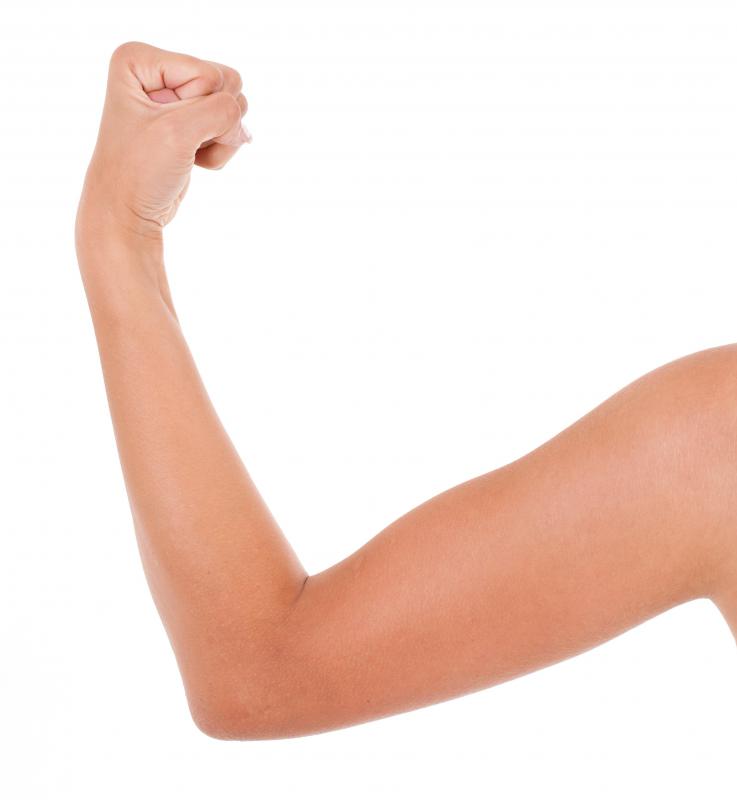At TheHealthBoard, we're committed to delivering accurate, trustworthy information. Our expert-authored content is rigorously fact-checked and sourced from credible authorities. Discover how we uphold the highest standards in providing you with reliable knowledge.
What is a Synergist Muscle?
A synergist muscle is a muscle which works in concert with another muscle to generate movement. These muscles can work with the so-called agonists or prime movers which surround a joint, or the antagonistic muscles, which move in the opposite direction. For many common movements, from turning the head to pointing the toes, a synergist muscle or group of muscles is required.
Prime movers are designed to move a joint in a particular direction, but a single prime mover or group of prime movers requires a synergist muscle to control the movement. Synergist muscles stabilize muscle movements to keep them even, and they control the movement so that it falls within a range of motion which is safe and desired. One could think of these muscles as helping hands which focus the effort of the movement to create a high level of control. By working synergistically, muscles also reduce the amount of work they need to do, which can improve endurance.

Sometimes, a synergist muscle can form part of what is known as a fixator group. Fixators are designed to “fix” or stabilize a joint. For example, when people stand up, fixator groups at the ankles keep the joints stable so that the ankles will not bend or wobble, causing difficulties with balancing. Fixator groups are also what allow people to isolate movements to a specific joint or area of the body, with the muscle group holding nearby joints in place.

A good example of a pair of synergist muscles can be found in the elbow, where the brachioradialis and biceps work together to extend or flex the arm by moving the elbow joint. Relationships between muscles can also change, depending on the actions involved, with muscles sometimes acting as a synergist muscle, and sometimes working alone or as an antagonist. The biceps and triceps muscles, for example, are considered antagonists because they move the elbow joint in opposite directions.

When people build and tone muscle for physical fitness, they often need to pay attention to working complete muscle groups by moving joints in different ways, to promote even development of muscle, including the synergist muscles which can help to stabilize joints and exert control over muscle movements. By ensuring that muscle groups are worked in a variety of ways, people can improve the strength of all of the muscles which surround a joint, improving range of motion and general fitness in all directions, rather than just one.
AS FEATURED ON:
AS FEATURED ON:













Discussion Comments
A synergist muscle joins in and assists the prime mover; it is not a stabilizer! A fixator helps maintaining a stable position. The antagonist muscle (in relation to the prime mover) relaxes, as muscles tend to work in pairs- one side contracts as the opposite side relaxes.
@ Fiorite- Think of the terms synergist and agonist as a descriptor that describes the purpose of the muscle it is referred to. A synergist muscle can be the same as an agonist,or it can work with an agonist to perform a similar function. A synergist muscle prevents a muscle from oversextnding. It acts as a brake to protect the tendon or to perform fine motor skills. They can be big or small to increase precision or help absorb impacts.
The bicep preventing the overextension of the tricep will help to prevent injuries like tennis elbow and pitching injuries. Conversely, a tricep can act as a synergist when it prevents the bicep from overcontracting giving the arm more control to perform precise movements.
What is the difference between a synergist and an agonist muscle? If they are similar then I would assume that synergist muscles can be more than just stabilizing muscles. It would make me think that a synergist muscle can be a large muscle like a bicep or a tricep.
So synergist muscles are stabilizer muscles. From what I know, these are the muscles that make a person plateau when working out. Changing up the exercise to focus on a different part of the same muscle groups is often what is needed to keep the synergist muscles toned and in shape. I would also assume that these are the muscles that often limit a person when they are injured.
I was always taught that I should use free weights in the gym instead of machines. Using free weights strengthens the stabilizer muscles and prevented injury. I also know that these are the muscles that need to be stretched and warmed up before a workout begins. If a warm up is not completed before working out, then you can risk injury, injury that is sometimes serious.
Post your comments